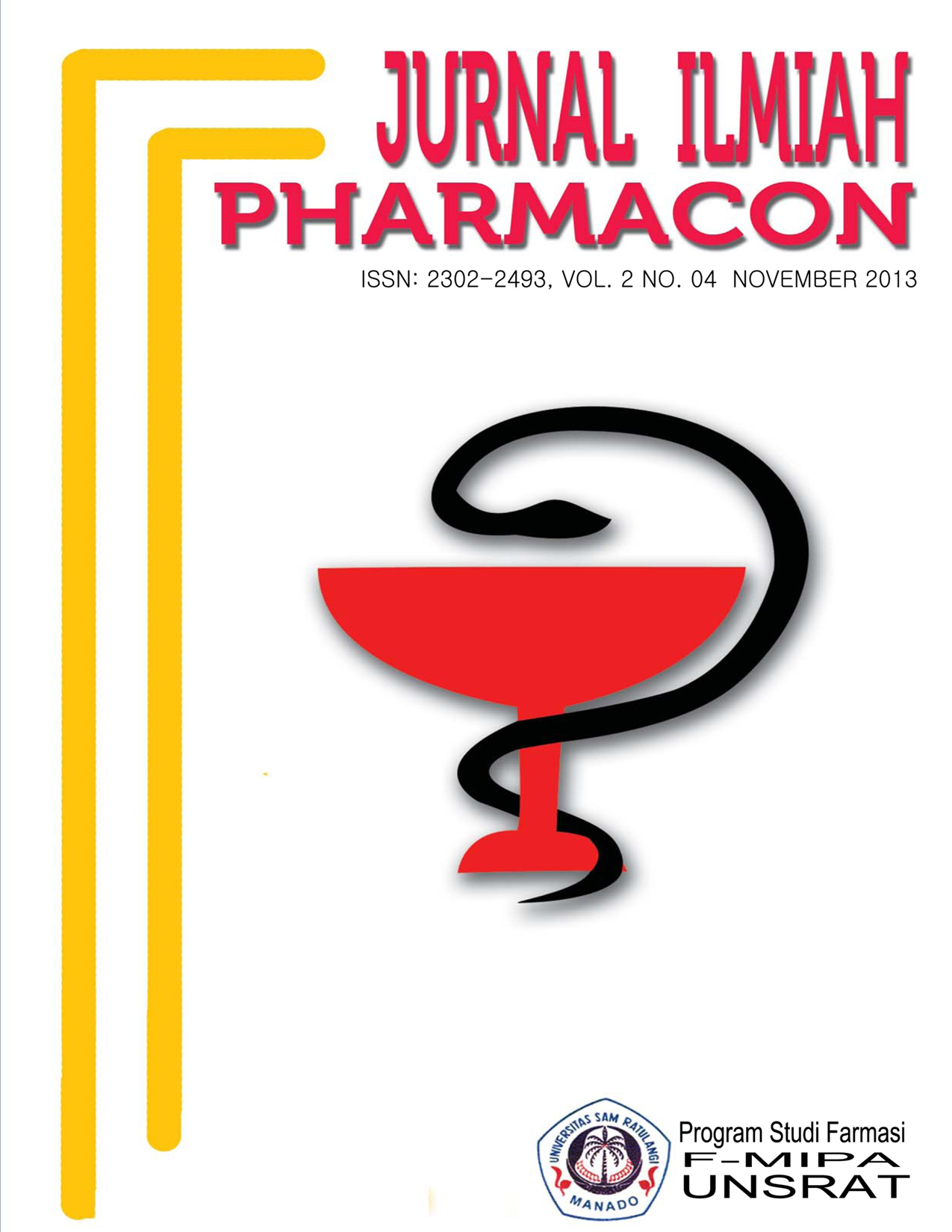UJI FITOKIMIA DAN AKTIVITAS ANTIOKSIDAN DARI EKSTRAK DAUN BAWANG KUCAI (Allium tuberosum Rottl. Ex Spreng) MENGGUNAKAN SPEKTROFOTOMETER UV-VIS
DOI:
https://doi.org/10.35799/pha.7.2018.21417Abstract
UJI FITOKIMIA DAN AKTIVITAS ANTIOKSIDAN DARI EKSTRAK DAUN BAWANG KUCAI (Allium tuberosum Rottl. Ex Spreng) MENGGUNAKAN SPEKTROFOTOMETER UV-VIS
Meidi Y Mangkasa1), Johnly A Rorong1) dan Audy D. Wuntu1)
1)Jurusan Kimia Fakultas MIPA UNSRAT Manado, 95115
ABSTRACT
This study aims to determine the secondary metabolic compounds contained in the onion extract of chives of Allium Toberosum Rottl Ex. Spreng and determine the antioxidant activity of chives extract. Chives onion powder was extracted by maceration with petroleum ether, ethyl acetate and methanol solvent for 3 x 24 hours and then evaporated until getting a thick extract. Determination of the water content of chives on chives obtained an average of 4.427%. Determination of the total phenolic was measured by the Folin-Ciocalteu method. Phytochemical test results indicate the presence of flavonoid and saponin compounds. The results of antioxidant activity using Ferric Reducing Antioxidant Power (FRAP) gave a total antioxidant value of ethyl acetate extract of 47,10345 mmol/g, methanol extract of 45,2931 mmol/g and petroleum ether extract of 9,689655 mmol/g which means ethyl extract acetate has the greatest ability to reduce Fe3+ to Fe2+. The results of antioxidant activity using 1-1-dhypenyl-2-pikrilhidrazin (DPPH) gave IC50 value of ethyl acetate extract of 179,5622 µg/mL, methanol extract of 385,6795 µg/mL and petroleum ether extract of 429,3103 µg/mL which means that ethyl acetate extract has the greatest ability to counteract free radicals. Chives onion have antioxidant activity in counteracting free radicals and can reduce Fe3+ to Fe2+.
Keywords: Chives, Phytochemicals, Ferric Reducing Antioxidant Power (FRAP), 1-1-dhypenil-2-pikrilhidrazin (DPPH).
ABSTRAK
Penelitian ini bertujuan untuk mengetahui senyawa metabolic sekunder dalam ekstrak daun bawang kucai (Allium Toberosum Rottl Ex. Spreng) dan menentukan aktivitas antioksidan dari ekstrak daun bawang kucai. Serbuk daun bawang kucai diekstraksi secara maserasi dengan pelarut petroleum eter, etil asetat dan methanol selama 3 x 24 jam dan selanjutnya dievaporasi sampai mendapatkan ekstrak kental. Penentuan kadar air yang diperoleh rata-rata 4,427 %. Penentuan kandungan total fenolik dengan metode Folin-Ciocalteu. Hasil uji fitokimia menunjukan adanya golongan senyawa flavonoid dan saponin. Hasil Aktivitas antioksidan menggunakan reagen Ferric Reducing Antioxidant Power (FRAP) memberikan nilai total antioksidan ekstrak etil asetat sebesar 47,10345 mmol/g, ekstrak methanol sebesar 45,2931 mmol/g dan eksrak petroleum eter sebesar 9,689655 mmol/g yang berarti ekstrak etil asetat memiliki kemampuan yang paling besar dalam mereduksi Fe3+ menjadi Fe2+. Hasil aktivitas antioksidan menggunakan reagen 1,1-diphenyl-2-picrylhydrazyl (DPPH) memberikan nilai IC50 untuk ekstrak etil asetat sebesar 179,5622 µg/mL, ekstrak methanol sebesar 385,6795 µg/mL dan eksrak petroleum eter sebesar 429,3103 µg/mL yang berarti ekstrak etil asetat memiliki kemampuan yang paling besar dalam menangkal radikal bebas. Daun bawang kucai memiliki aktivitas antioksidan dalam menangkal radikal bebas dan dapat mereduksi Fe3+ menjadi Fe2+.
Kata Kunci : Bawang Kucai, Fitokimia, Ferric Reducing Antioxidant Power (FRAP), 1-1-dhypenil-2-pikrilhidrazin (DPPH).
Downloads
Published
How to Cite
Issue
Section
License
Authors who publish with this journal agree to the following terms:
- Authors retain copyright and grant the journal right of first publication with the work simultaneously licensed under a Creative Commons Attribution-NonCommercial 4.0 International License that allows others to share the work with an acknowledgement of the work's authorship and initial publication in this journal.
- Authors are permitted and encouraged to post their work online (e.g., in institutional repositories or on their website) prior to and during the submission process, as it can lead to productive exchanges, as well as earlier and greater citation of published work (See The Effect of Open Access)










